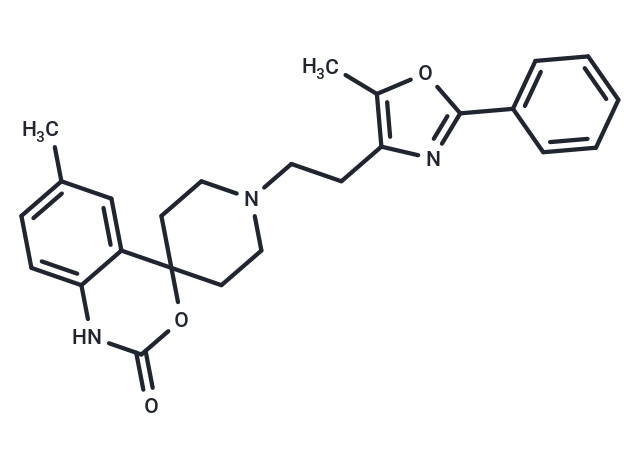Shopping Cart
- Remove All
 Your shopping cart is currently empty
Your shopping cart is currently empty

RS 504393 is a highly selective CCR2 chemokine receptor antagonist (IC50s: 89 nM and > 100 μM for human recombinant CCR2 and CCR1).

| Pack Size | Price | Availability | Quantity |
|---|---|---|---|
| 1 mg | $43 | In Stock | |
| 5 mg | $98 | In Stock | |
| 10 mg | $168 | In Stock | |
| 25 mg | $369 | In Stock | |
| 50 mg | $553 | In Stock | |
| 100 mg | $798 | In Stock | |
| 1 mL x 10 mM (in DMSO) | $112 | In Stock |
| Description | RS 504393 is a highly selective CCR2 chemokine receptor antagonist (IC50s: 89 nM and > 100 μM for human recombinant CCR2 and CCR1). |
| Targets&IC50 | α1A-adrenoceptor:72 nM (cell free), CCR2:89 nM (cell free) |
| In vitro | RS-504393 inhibit MCP-1-stimulated calcium influx into CCR2-CHL cells. The IC50 values are 35 nM [1]. CCR2 antagonist, RS 504393 treatment, suppressed allergen induced β-hexosaminidase release significantly. This inhibitory effect was partially reversed by supplementation of recombinant MCP-1 protein (100 pg/mL) [2]. |
| In vivo | Whereas vehicle-treated mice developed clear signs of acute inflammation, RS 504393-treated mice failed to show clinical signs of immediate hypersensitivity. No effect was observed in naive animals. The degranulation of mast cells was significantly inhibited in RS 504393-treated mice but had no effect on naive mice [2]. Similar to the results obtained from CCR2-deficient mice, the treatment with RS-504393 significantly reduced renal pathology, especially the extensive interstitial fibrosis mediated by a decrease in type I collagen synthesis [3]. |
| Kinase Assay | Briefly, binding was measured using membranes prepared from two cell lines, THP-1 and CCR2-CHL cells. Each competition assay was composed of cell membranes, 50 pM 125I-MCP, MCP buffer, protease inhibitors, and test compound. Equilibrium was achieved by incubation at 28?°C for 90 min. Membrane-bound 125I-MCP was collected by filtration through GF/B filters presoaked in polyethyleneimine and bovine serum albumin, followed by four rapid washes with approximately 0.5 ml of ice-cold buffer containing 0.5 M NaCl and 10 mM HEPES, pH 7.4. MCP buffer consists of 50 mMHEPES, pH 7.2, 1 mM CaCl2, 5 mMMgCl2, and 0.1% bovine serum albumin. Protease inhibitors include 0.1 mM phenylmethylsulfonyl fluoride, 1 μM leupeptin, and 0.35 mg/ml pepstatin. THP-1 cells are a human monocyte cell line that express both CCR1 and CCR2. CCR2-CHL cells are Chinese hamster lung cells that have been stably transformed with an expression vector bearing the human CCR2b receptor [1]. |
| Cell Research | Briefly, cytosolic calcium influx was measured in CCR2-CHL cells loaded with the fluorescent dye Fura-2-AM. Quantitation of signal intensity used the integrated signal intensity for 82 s after the addition of chemokine and thus has units of M·s. Antagonism by various compounds of calcium influx was measured using an approximate ED50 dose of MCP-1 (3 nM) and an approximate ED25 dose for MCP-3 (5 nM). Chemotaxis was measured over 1 h using THP-1–5X cells in a 96-well Boyden chamber apparatus. Cell migration through the polycarbonate filter was quantified by fluorescent staining using propidium iodide in 0.1% Triton X-100. These assays typically gave stimulated to unstimulated migration of 6-fold, range 4–10-fold, using a maximally effective concentration of MCP-1. Chemotaxis antagonist measurements used 3 nM MCP-1 or RANTES; these concentrations are near the ED95 attractant concentration for MCP-1 and for RANTES as agonists. The data are expressed by normalization to the uninhibited migration caused by the agonist chemokine. The antagonist was present in both chambers of the Boyden apparatus [1]. |
| Animal Research | To evaluate the therapeutic effects of MCP-1/CCR2 signaling, either propagermanium (3 or 8 mg/kg orally once a day) or RS-504393 (2 mg/kg orally twice a day) was mandatorily injected into their mouths to wild-type mice from 3 days before ureteral ligation until the day of sacrifice. In addition, to determine the viability for the usage of CCR2 antagonists for the treatment of renal fibrosis, propagermanium (8 mg/kg) was given daily, beginning 4 days after ureter ligation. For pathological examination, both the obstructed and contralateral kidneys were harvested from UUO animals 4, 7, and 14 days after ureteral ligation (n = 5 at each time point). Untreated age-matched male wild-type mice and CCR2-deficient mice were used as normal control (n = 6 for each group). Since propagermanium treatment was started from 3 days before ureteral ligation, mice treated with propagermanium for 3 days at day 0 were used as a negative control (n = 5) [3]. |
| Molecular Weight | 417.5 |
| Formula | C25H27N3O3 |
| Cas No. | 300816-15-3 |
| Smiles | Cc1oc(nc1CCN1CCC2(CC1)OC(=O)Nc1ccc(C)cc21)-c1ccccc1 |
| Relative Density. | 1.282g/cm3 |
| Storage | Powder: -20°C for 3 years | In solvent: -80°C for 1 year | Shipping with blue ice. | |||||||||||||||||||||||||
| Solubility Information | DMSO: 10 mg/mL (23.95 mM), Sonication is recommended. H2O: Insoluble | |||||||||||||||||||||||||
Solution Preparation Table | ||||||||||||||||||||||||||
DMSO
| ||||||||||||||||||||||||||

Copyright © 2015-2025 TargetMol Chemicals Inc. All Rights Reserved.